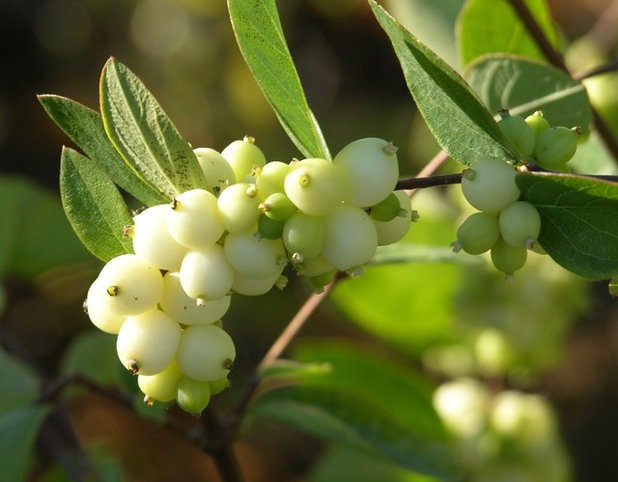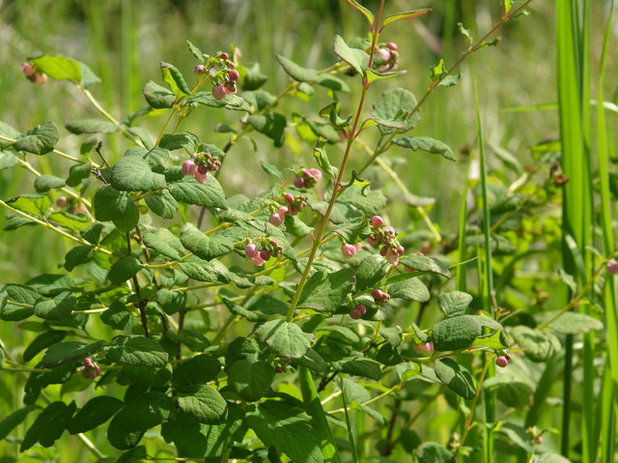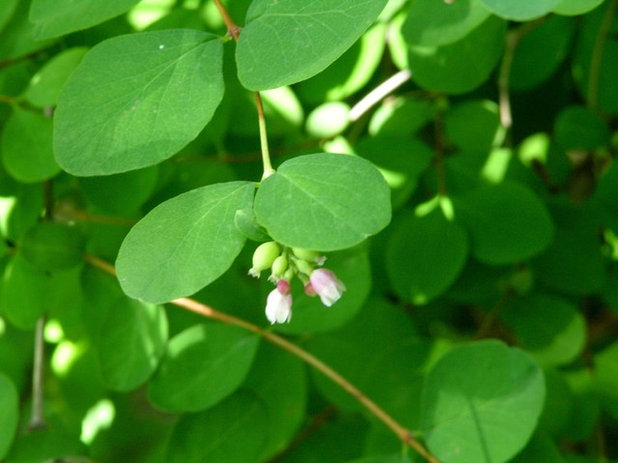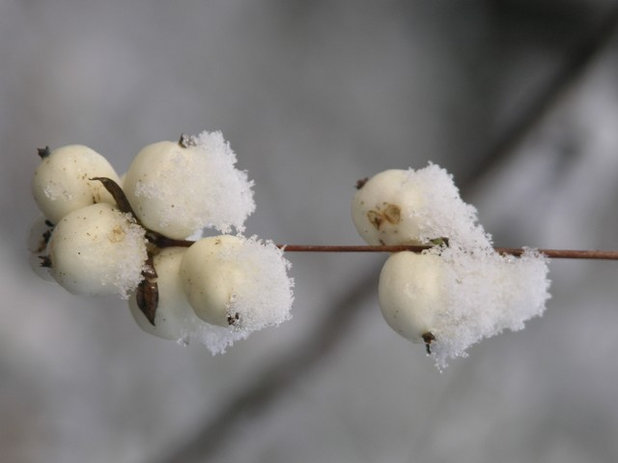Wander along nearly any stretch of Pacific Northwest roadside or through a forest clearing, and you will soon encounter vast thickets of snowberry (
Symphoricarpos albus). Most commonly seen in roadside ditches in farming areas, growing with steeplebush (
Spiraea douglasii) and tall Oregon grape (
Mahonia aquifolium), snowberry is a common contributor to mixed hedges that provide a valuable habitat for birds, insects and mammals.
While it’s important to wildlife, snowberry also brings visual garden delights in every season. In early spring bright green, roundish-lobed foliage unfurls on arching branches. Rather late, in early summer, pretty pink, urn-shaped flowers appear to drip from branch tips, providing nectar to hummingbirds and pollen for insects. In summer the foliage takes on a bluish cast, sometimes turning pale yellow before dropping in the autumn, although generally showing little fall color. But it is when the leaves drop that the round, berry-like drupes are highlighted. From afar they look like a haze of tiny, sparkling white ornaments suspended in midair. Up close the ghostly white orbs glisten in the low seasonal light, set against deep green moss and ferns and dark brown earth — laden with snow-white drupes, snowberry is surely at its most spectacular in the depths of winter.
Snowberry is abundant throughout the Northwest, from Canada to Northern California, but is also at home throughout the rest of the northern U.S., including the East Coast.

Hansen's Northwest Native Plant Database
Botanical name: Symphoricarpos albusCommon names: Common snowberry, waxberry
Origin: Western and eastern North America and Canada
Where it will grow: Hardy to -30 degrees Fahrenheit (USDA zones 4 to 10; find your zone)
Water requirement: Snowberry is unfussy; once it’s established, no supplemental summer water is required.
Light requirement: Shade to sun
Mature size: 3 to 6 feet tall plus suckers
Benefits and tolerances: Small blossoms provide nectar for hummingbirds and pollen for insects; the fruit is enjoyed by many songbirds, including grosbeaks, robins, thrushes, towhees and waxwings, as well as by a variety of mammals
Seasonal interest: Pretty light green spring foliage on arching stems; delicate pink flowers in early summer; striking white berries all winter
W
hen to plant: Fall to spring is ideal, but it’s unfussy

Hansen's Northwest Native Plant Database
Distinguishing traits. Common snowberry has a mounding habit, often suckering vigorously and providing a shrubby refuge for songbirds. The arching stems of snowberry look pretty in spring and summer. When left to its own devices or gently thinned from the base annually, the plants develop a graceful look en masse, both in leaf and after the foliage has dropped.
How to use it. Common snowberry is deciduous and has a wild, informal look, so is best suited for less formal areas of the garden. It will grow most densely and produce the most abundant flowers and fruit in partial to full sun and moist soil.
Plant in the back forty, where the the arching, warm brown stems and snowy white berries can be enjoyed as a backdrop to more formal plantings in winter. It will be relished by wildlife, whether humans see it or not, offering shelter, nectar and pollen. As it is tolerant of drought, grows in sun or shade, and has a vigorous root system, snowberry can be used to help stabilize modest banks and hillsides. Trim back one-third of the stems to the base each spring for a pretty contribution to the border, with ground covers, ferns and hostas. Mildew can occur later in summer, but it rarely disfigures the plant.

Hansen's Northwest Native Plant Database
Planting notes. Snowberry is fast growing and suckers vigorously. Provide it with sufficient water and decently draining soil, and it will soon become established and provide a valuable habitat for all variety of wildlife in your garden.
Try trailing snowberry (
Symphoricarpus mollis) in the same settings as common snowberry. Trailing snowberry thrives in sun to shade but is perhaps a bit more tolerant of dry, sunny areas, particularly on slopes and hillsides. It grows just 1 foot to 2 feet tall and suckers and roots along trailing stems. The whole plant, including its leaves and fruit, is a bit smaller than common snowberry.

Hansen's Northwest Native Plant Database
More: Browse plants native to other regions of the U.S.





